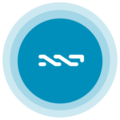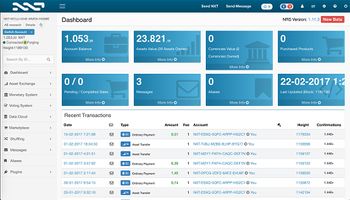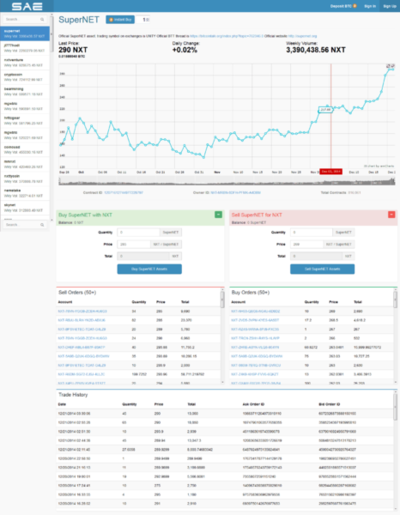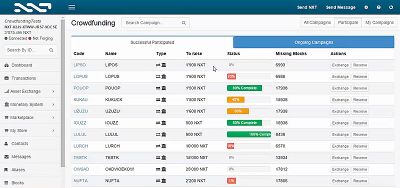NXT

NXT coin is an open-source cryptocurrency and payment network launched in November 2013 by anonymous software developer BCNext. Nextcoin uses proof-of-stake to reach consensus for transactions – as such there is a static money supply and, unlike bitcoin, no mining. Nxt was specifically conceived as a flexible platform around which to build applications and financial services.[1] It has an integrated Asset Exchange (comparable to shares), messaging system and marketplace. Users can also create new currencies within the system. The last major release enabled Multisignature capabilities and a plugin-system for the client.
NXT coin has been covered extensively in the “Call for Evidence” report by ESMA, to which the community of NXT coin responded in July 2015.[2]
Contents
NXT Review
NXT was created without announcing any ICO (Initial coin offering) with total 1,000,000,000 coins amount. On 28 September 2013 Bitcointalk.org member BCNext created a forum thread announcing the proposed launch of Nxt as a second generation cryptocurrency and asking for small bitcoin donations to determine how to distribute the initial stake. On 18 November 2013 fundraising for Nxt was closed. The genesis block was published on 24 November 2013. It revealed that 1,000,000,000 coins had been distributed to 73 stakeholders in proportion to their level of contribution. The source code was partially released on 3 January. The full source code was released on 1 March 2014 under the MIT License.
Just as with bitcoin, the NXT blockchain is at the core of currency. However, NXT coin’s code was written completely from scratch and has departed in several ways from existing cryptocurrencies. Most notably, in one of his founding statements, BCNext asked the community not to consider the NXT coin as the important part, but rather to create currencies on top of it – possibly devaluing the core currency.
- Nxt is coded in Java.
- Nxt was the first currency to rely purely on proof-of-stake for consensus. Allowing a block creation rate of roughly one minute.
- The standard client works as a brain-wallet: Instead of storing keys in a cryptocurrency wallet file, security works via a secret passphrase. This means it can be accessed from any instance of the Nxt software.
Developer accessibility
The core structure and the client features of NXT coin are aimed at facilitating external development.
- No centralized service is needed for accessing the API, not even a node run by the developer, since named peers of the network can be directly accessed via API calls.
Proof-of-stake consensus mechanism
While bitcoin uses hashing power as proof for verifying transactions, Nxt works with the stake-size the user owns. Block authors are selected in a practically random manner, with greater amounts of stake increasing the likelihood of adding a block to the chain. While in the case of bitcoin the cost of investing in mining gear serves as an incentive not to attack the network, anyone seeking to attack Nxt would in the process necessarily reduce the value of their personal coin holdings. This effectively avoids the security issue of a miner gaining more than 50% of the hashing power and attacking the network.
Forging
Since NXT coin has an unchanging coin supply, no new units are created for block rewards. Instead the transaction fees are passed on. After owning NXT for about one day (1440 confirmations),[3] the Nxt software will begin to contribute to the block generation process and can potentially earn coins for as long as an account is “unlocked”.
At the moment Nxt is open to attack if any account has 51% of the total coin supply that is forging. As outlined in the founding statements future versions of Nxt will include “transparent forging”, a process which allows the software to predict which accounts will forge upcoming blocks. This is basically done by iterating through all active accounts and seeing which one has the highest “hit”. Transparent forging rapidly increases transaction processing, since the account that will forge the next block is known. Another benefit of this feature is that accounts that are due to forge, but do not, will be penalized by having their forging power temporarily reduced to zero. This raises the threshold for an attack to 90%. The Proof-of-Stake algorithm requires little computation and energy, and can run on smartphones and small devices like the Raspberry Pi platform.
What is NXT coin features?
The core infrastructure of Nxt is complex. This adds risks as compared to the more lean bitcoin, but makes it easier for external services to be built on top of the blockchain.
Asset exchange
A special feature of NXT is the presence in the system of its own exchange called Asset Exchange.
Thus, the developers are worried about their users, because there is no guarantee that the popular exchange for today at one point just will not close. In turn, Asset Exchange will exist as long as there is Nextcoin itself, in addition, this exchange is exempt from internal commissions. Of the disadvantages of this exchange it is worth noting that trades on it are not moving very actively, and the total sales of Nextcoin do not exceed a few percent. Unlike bitcoin, Nextcoin has the ability to use additional services, such as chat, peer-to-peer exchange, colored coins, decentralized DNS and other chips. Through the use of PoS (proof of ownership) rather than PoW (proof of work), as in most other cryptocurrencies, NXT does not have many problems of the previous generation (no emissions, and hence no exchange rate fluctuations and coin instability).
It is also necessary to note the energy efficiency of the protocol, because the PoS-mechanism does not require high computing power (like many other digital currencies). However, this advantage has another side. The fact is that with such a model (PoS), all coins must be distributed from the very beginning of the existence of the currency. If this is not done, there is a high risk of Sybil attack (multiple identifiers at one of the hosts).
Trading on a decentralized peer-to-peer exchange, built into Nextcoin system, is also, of course, decentralized, removes trust issues and eliminates Commission fees. Of anonymity and security network that won’t hurt. Coins. We are talking about the so – called “colored” coins (colored coins) – this technology is built into the currency code. As such, the local wallet, like many other cryptocurrencies, is not here. This network uses the so – called “brain wallet” – brain wallet, which indicates that it is decentralized, and the place of its storage is the network.
Data storage
Arbitrary Messages enable the sending of encrypted or plain text on the NXT platform, which can also function to send and store up to 1000 bytes of data permanently, or 42 kilobytes of data for a limited amount of time. As a result, it can be used to build file-sharing services, decentralized applications, and higher-level Nxt services.
Alias System
The Alias System feature of NXT platform essentially allows one piece of text to be substituted for another, so that keywords can be used to represent other things – names, telephone numbers, physical addresses, web sites, account numbers or emails. This would for example allow for a decentralized DNS system similar to Namecoin.[4]
Voting system
Allowing holders of the currency or Nxt coins to vote in a cryptographically proven and externally verifiable way. This can be used for future development decisions, or for shareholder voting. It can also be applied to public elections and community based decision-making.
Plugin support
The standard Nxt client supports the installation of plug-ins. This makes it possible for external developers to add features or usability enhancements. The plug-ins are not contained in a sandbox.
Monetary System
Implemented in NXT coin version 1.4.8, the Monetary System allows the creation of currencies on the Nxt blockchain. These coins are backed by a specified amount of NXT, which can be redeemed if necessary. The possible properties range widely – including different models of inflation, exchange and the use of Proof-of-Work as distribution system.
Multi-signature and phased transactions
The latest client (1.5) supports a method (named Phasing for NXT platform) for requiring specific conditions for executing a transaction. Such as approval of multiple accounts or the passage of an interval of time.
NXT Exchanges
Most NXT crypto transactions are held on the HitBTC exchange. The coins are also available for trading on Binance, Poloniex, Upbit, CoinEgg and other crypto exchanges.
NXT Wallet
: See also: NXT Client, NXT Freewallet
The NXT wallet works in a different way then other cryptocurrency storages. NXT crypto currency does not store the user’s wallet on the physical device, but it uses a «Brain wallet» technology. The password-phrase is an origin sentence, not the quote from book, song or film. It is a NXT wallet password and wallet address.
All the important information for a NXT wallet access is stored in your brain. The chosen password is transformed into the private key to get an access to the wallet. Consequently, there is no needs to store anything on any device, all your money are securely stored in the Nxt crypto network.
NXT Price
On BitcoinWiki there is a relevant NXT price and market capitalization of the project in US Dollars (USD):
Criticism
Nothing at stake attacks
It is proposed that one could attack any proof-of-stake currency with zero costs. There are several proposed attack vectors. These include attempting to build blocks in every fork in the network, because doing so costs them almost nothing and ignoring any fork may mean losing out on the block rewards that would be earned if that fork were to become the chain with the largest cumulative difficulty.
NXT Mining and Distribution
Since NXT coin had no mining phase, all initial units were released to 73 people through a one-time fund raiser via bitcoins, after the announcement of the NXT project in the BitcoinTalk forums by its inventor BCnext.
User-generated passwords
To access an account, the user types a password or a passphrase from which a private key is calculated, unlike bitcoin, where private keys are typically stored in a wallet file and not directly visible to the user.
3rd party use
Local economies
On 18 September 2015, Wall Street investor Brian Kelly announced he would be investing in the NXT-based platform Drachmae, which has as its aim the revitalisation of the local economy of the Greek Island Agistri.
See Also on BitcoinWiki
External links
- NXT website
- NXT on Twitter
- NXT – BitcoinTalk forum
- Nextcoin (NXT) on Reddit
- NXT price and market state on Coin360


